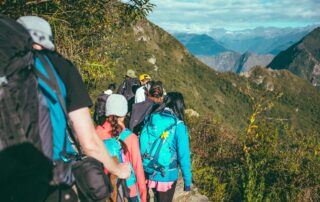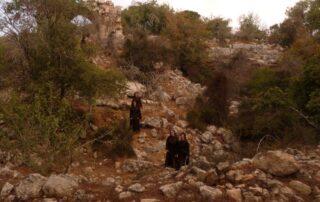 Pillar: Reverence
Pillar: Reverence
Laudato Si’ Action Plan Goals: Ecological Education, Ecological Spirituality
 Pillar: Reverence
Pillar: Reverence
Laudato Si’ Action Plan Goals: Ecological Education, Ecological Spirituality
Group (Grade Levels): All ages
Learning Goals:
- Learn how to experience particular place through immersion and observation
- Grow in the capacity to foster reverence for creation and one another
Materials needed: A natural area, appropriate shoes and clothing, water, trail map, first aid kit, snacks if you plan for a longer hike. Optional: field guides, taxonomic keys, binoculars, magnifying glasses, zipper-seal plastic bags for holding and observing invertebrates or small amphibians, paper and pencil
Estimated Time to Complete Activity: Could vary from an hour to a day
Estimated Number of Sessions if Activity Continues: Once a month to experience progression of seasons
Pre-planning:
- Choose a hike that is appropriate for your group’s skill level and time allotment. You can plan that a group of older children, teenagers or healthy adults will walk about two miles in an hour, with stops for experiences along the way. Younger children and out-of-shape adults may take an hour to walk one mile, with more breaks for resting or other experiences.
- Be aware of the regulations and fees associated with the place you choose to visit.
- Walk the route without your group before leading a group on it. Preferably this would happen just a few days before you lead the hike, so that you can be familiar with the route in general as well as any current obstacles or highlights you are likely to encounter. For example, it is good to know of potential concerns such as recently fallen trees, active bees’ nests, or high-water situations, as well as potential attractions such as wildflowers in bloom, ripe blueberries, or vernal pools with breeding amphibians.
- Plan for areas along the way where the whole group will stop, either for a rest break or for an activity. These areas should have ample space for the group to gather, not stand in a single-file line on the trail. Look for places where group members will be safe, and the ecosystem will remain intact if you step off the trail. For example, a relatively flat area of forest with fallen leaves underfoot and not many small plants, or an area of sand or pebbles, or a mowed field would all be places where your group could spread out safely for an activity. At waterfalls or scenic overlooks, plan how you will direct your group so they can enjoy the feature safely.
- It is helpful to have a co-leader or responsible adult group member designated as the “sweep” person on your hike. This person agrees to remain at the end of the line so that you will always know the group is together when you see him or her.
General Outline of Experience
Scripture passage and suggested introductory question
Proclaim the Gospel passage of the Road to Emmaus (Luke 24:13–35):
Now that very day two of them were going to a village seven miles from Jerusalem called Emmaus, and they were conversing about all the things that had occurred. And it happened that while they were conversing and debating, Jesus himself drew near and walked with them, but their eyes were prevented from recognizing him. He asked them, “What are you discussing as you walk along?” They stopped, looking downcast. One of them, named Cleopas, said to him in reply, “Are you the only visitor to Jerusalem who does not know of the things that have taken place there in these days?” And he replied to them, “What sort of things?” They said to him, “The things that happened to Jesus the Nazarene, who was a prophet mighty in deed and word before God and all the people, how our chief priests and rulers both handed him over to a sentence of death and crucified him. But we were hoping that he would be the one to redeem Israel; and besides all this, it is now the third day since this took place. Some women from our group, however, have astounded us: they were at the tomb early in the morning and did not find his body; they came back and reported that they had indeed seen a vision of angels who announced that he was alive. Then some of those with us went to the tomb and found things just as the women had described, but him they did not see.” And he said to them, “Oh, how foolish you are! How slow of heart to believe all that the prophets spoke! Was it not necessary that the Messiah should suffer these things and enter into his glory?” Then beginning with Moses and all the prophets, he interpreted to them what referred to him in all the scriptures. As they approached the village to which they were going, he gave the impression that he was going on farther. But they urged him, “Stay with us, for it is nearly evening and the day is almost over.” So he went in to stay with them. And it happened that, while he was with them at table, he took bread, said the blessing, broke it, and gave it to them. With that their eyes were opened and they recognized him, but he vanished from their sight. Then they said to each other, “Were not our hearts burning [within us] while he spoke to us on the way and opened the scriptures to us?” So they set out at once and returned to Jerusalem where they found gathered together the eleven and those with them who were saying, “The Lord has truly been raised and has appeared to Simon!” Then the two recounted what had taken place on the way and how he was made known to them in the breaking of the bread.
How might we experience Jesus joining us on our walk today?
Laudato Si’, n. 233 and suggested introductory questions
“The universe unfolds in God, who fills it completely. Hence, there is mystical meaning to be found in a leaf, in a mountain trail, in a poor person’s face. The ideal is not only to pass from the exterior to the interior to discover the action of God in the soul, but also to discover God in all things.”
- What natural objects seem insignificant to us or do not seem to matter much?
- What natural objects are so big that they make us feel insignificant?
- Share about a time that you have sensed the presence of God in something that He created.
Close with a prayer.
- Concrete opening experience: Review the map together and tell some highlights of the route, including landmarks and various habitats you will walk through.
- Have group members share their hopes for the experience as well as any worries they may have. Address these as needed.
- Lead up to key point: As we are immersed in this place today, we are going to see how God is present here and how we are connected to Him and His creatures.
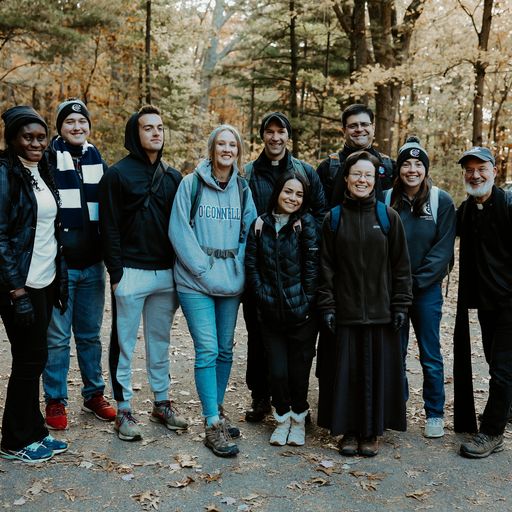
Orientation to tools/elemental techniques:
- Show the participants how to follow the map, trail signs, and blazes (but, especially with young children, keep the group together while walking and be sure everyone is present at every trail intersection).
- Discuss how to take care of our physical needs and our surrounding environment while on the trail (eating, drinking, rest breaks, bathroom, Leave No Trace principles).
- Do not take time before beginning the hike to orient the group to the field guides and other identification or observation tools. Instead, wait until it is time to use them.

- Along the way, you may choose to have the participants work in small groups on observation activities. These small groups should be composed of 2 to 4 members who are given a designated focus area. (If possible, arrange this: one group in a sunnier spot, one near water, etc.)
- If you are using identification guides, they may list the various species they identify. If not, they may list by general characteristic, i.e., evergreen or deciduous trees, shrubs, small or large birds, mammals, etc. They may also observe signs of animals which are not currently present, but use the habitat, i.e., dens, nests, tracks, scat, feeding signs, etc.
- Gather all of the small groups after 15 to 20 minutes to compare notes. How might the organisms the groups have found depend upon one another? Are there habitat differences between different groups’ study areas?
- How does the physical environment affect the types of creatures we encounter there?
- As an alternative to this type of biodiversity study, you could make different stops to focus on different types of organism, such as a tree stop, a bird stop, a flower stop, etc.
- Different stops could also focus on different habitat types.
- For younger or less scientifically-focused groups, try some sensory activities along the way or at stops. Have them list the colors they see, really looking at tree trunks: are they brown? How many shades of green are there? How many colors are in the sky right now? Where do we see bright colors?
- Have the group pause for a short “silence break” now and then to listen to the sounds around them.
- Encourage touching and smelling natural items that are safe: moss, tree bark, flowers, soil, rough or fuzzy leaves, etc.
- If you are absolutely confident in the identity and edibility of a natural item and there is plenty there, allow participants to taste. It is a memorable experience for many to eat a sourwood leaf or new pine needle, chew on a twig of yellow birch, or even enjoy wild berries.
- For older children, teenagers, and adults, try a “solo walk” for a part of the hike.
- This works best after the participants have been hiking for over an hour and have shown themselves to be comfortable in the environment. It must be done along a very well-marked stretch of trail with no intersections or possibility of becoming confused, and you will need a responsible sweep person with a watch or timer.
- After discussing with your group the need we all have for a relationship with God that can be nurtured with silence and reflection, explain to them that they will soon be given a time of silence and reflection in this natural setting. Tell them that you, the leader, will walk down the trail first and will stop at the next gathering place (this should be between half a mile and one mile away). The sweep person will send another hiker down the trail every three minutes (more or less, depending on the time you have available).
- Each hiker is to walk quietly at an average pace, taking the opportunity to experience the environment without the distractions of other group members. They will know it is time to stop when they reach you. As participants arrive at your gathering space, encourage them to remain quiet in respect for the others who are still taking their quiet walk. Journaling, sketching, or even napping are good ways to achieve this.
- Once everyone has completed the solo walk, give the group time to share about their experiences.
- You may want to try an artistic activity.
- For example, have your participants create a small sculpture using sticks, rocks, and fallen leaves.
- Give them time to sketch the landscape or an interesting thing they have seen.
- If there are soft pebbles (like shale, slate, sandstone, or even pieces of brick) by a stream, show the participants how rubbing two wet pebbles together grinds them down to create a watercolor paint, perfect for painting on their faces or on paper.
- Some stops, even for adults, can be simply for play.
- Skip stones, float sticks down a stream, chase falling leaves, have a snowball fight, try hide and seek…
- Before returning to the trail after stopping, offer a prayer of praise or gratitude for the ways God has shown his presence during your stop.
- You could offer this prayer yourself the first couple of times and then invite participants to do so.
- Ideas for follow-up in future sessions:
- Keep your group’s list of highlights, memories, and findings.
- Hike the same trail in the next season and compare.
- Alternatively, hike the same trail at a different time of day, such as at sunrise or after dark.
- Hike another trail in the same region and compare habitats.
- Allow each group member to share his or her highlights of the experience.
- As a group, draw up a list of memories and findings.
- These could be organisms observed, geological phenomena, weather patterns, historical landmarks, or other aspects of the place itself.
- They could also relate to the interpersonal dynamics of the group, the physical challenges of hiking, or self-reflective or spiritual insights.

- Compare what we find in different places. How is each plant, animal, etc. adapted for living in its habitat?
- How could the creatures we see here be connected with one another?
- What are some differences in what we hear, smell, and feel in each place?
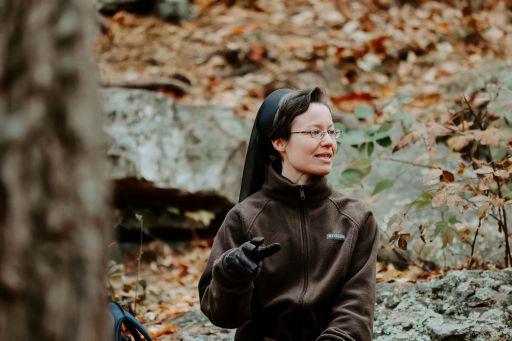
Proposed quotations and discussion questions:
- Revisit the questions from the gathering and prayer at the beginning. How have our perspectives changed or deepened through our experience?
- How have we experienced a connection with God along our trail? With one another? With creation?
- What are some ways you can continue the experience we have had today and perhaps share it with others?
- Laudato Si’, n. 221: “Each creature reflects something of God and has a message to convey to us, and … Christ has taken unto himself this material world and now, risen, is intimately present to each being, surrounding it with his affection and penetrating it with his light.”
- How can we see the “something of God” reflected in each creature? How can we hear the message?
- How does this relate to our calling to reverence all creatures?
- Why does it make a difference to us, and to our understanding of creation, that Christ became incarnate in the material world?
Potential analogies:
- Trail as a pathway through life; following God’s will
- Variety of creatures encountered as variety of ways to encounter God
- Interactions between animals as they relate to interactions between humans
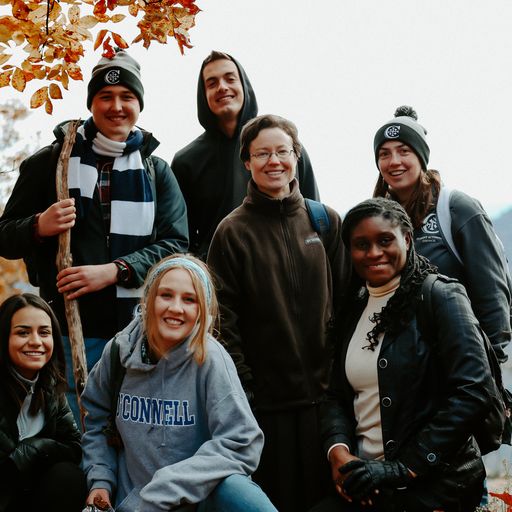
- Laudato Si’, 220: “[Ecological conversion] also entails a loving awareness that we are not disconnected from the rest of creatures, but joined in a splendid universal communion. As believers, we do not look at the world from without but from within, conscious of the bonds with which the Father has linked us to all beings.”
- How are living things linked to each other?
- How are we linked to other beings?
- What is the difference between looking at the world from without and looking at it from within?
- Discuss the relationship of St. Francis of Assisi to creation, e.g., his naming of creatures as brothers and sisters.
- What did St. Francis mean when he called creatures his brothers and sisters?
- Why are some brothers and others sisters?
- Could we say the same about something we encountered on our hike today? Did some aspects of creation seem like brothers or sisters to us? In what ways?
Cross-references to other experiential learning activities: Little Portion Experience, Flower-Gazing and Poetry, Community Building Game

